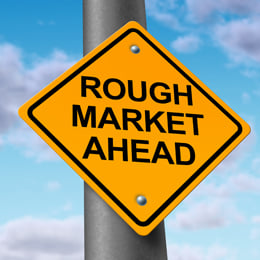 After I wrote Friday’s post, the market proceeded to drop even further, and it opened today with another dip. Time to reevaluate where we stand.
After I wrote Friday’s post, the market proceeded to drop even further, and it opened today with another dip. Time to reevaluate where we stand.
First, as always, it’s important to keep things in perspective. As I write this, the S&P 500 is down just over 6 percent from the peak. We’re still up about 2.5 percent for the year, and more than 11 percent for the past 12 months. Even with the drop, we’re in a pretty good place.
No need to panic, but some concern warranted
As I’ve said before, I start paying attention when the market cracks its 200-day moving average, which happened this morning. Historically, this technical level (represented by the pink line in the chart below) has often marked a change in trend from a rising market to a declining market.

Over the past five years, we’ve broken below the 200-day average six times. Of those instances, two in 2012 were short-lived, but the breaks in 2010 and 2011 were longer and more severe, showing about a 15-percent decline from the prior peak.
Based on this data, we can see that breaking the average doesn’t necessarily spell trouble, but it could well mean significant further declines.
S&P 500 and Russell 2000 drop in tandem
The S&P 500 consists of large, solid companies—the “blue chips”—which investors generally consider less risky than smaller companies. Historically, this has been the case to some degree, but in many ways, smaller companies have behaved more or less the same as large companies, especially over the past five years—at least until recently.

Over the past several months, the Russell 2000, an index of small-cap stocks, has done much worse than the S&P 500. It broke its 200-day moving average twice this year, then recently broke through it again, along with the S&P 500. The fact that the S&P 500 is now breaking down at the same time as the Russell 2000 is somewhat worrisome.
Investors may be rethinking risk
Owning stocks is all about risk. Small-cap stocks are considered riskier, so they’re a better proxy for how investors really feel. When investors run away from small-cap stocks but continue to drive up large-caps, it suggests that they aren’t appreciating the real risk of large-cap stocks. With large-caps now following small-caps down, investors may be reevaluating just how risky they are—and pulling back accordingly.
Though it still isn’t time for serious concern, it is time to prepare for the possibility of further declines. Until we see a close well below the 200-day average, the market remains in an uptrend—but we’re definitely getting closer to that line.
In the next week or so, we’re likely to see the market either bounce back (as it did in 2012) or drop further (as it did in 2011). Either scenario is quite possible, so the appropriate course is to prepare for the worst and hope for the best.


 Print
Print


